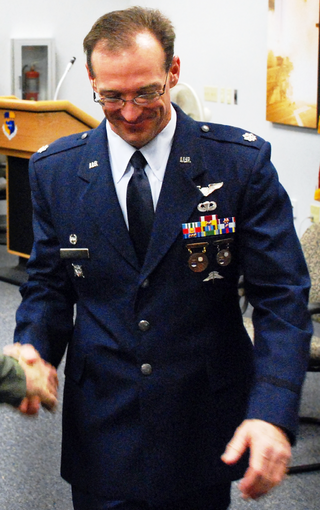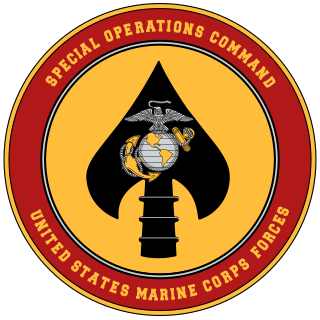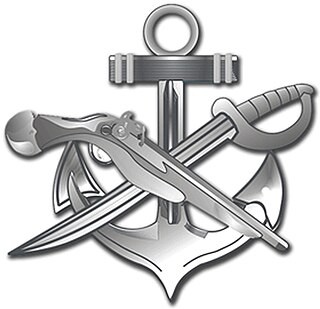
Force Reconnaissance (FORECON) are United States Marine Corps deep reconnaissance companies that supply military intelligence to the command element of the Marine Air-Ground Task Force (MAGTF). Force Reconnaissance companies unlike USMC division reconnaissance report to the Marine expeditionary force (MEF) and provide direct action and deep reconnaissance during large-scale operations.
A United States military occupation code, or a military occupational specialty code, is a nine-character code used in the United States Army and United States Marine Corps to identify a specific job. In the United States Air Force, a system of Air Force Specialty Codes (AFSC) is used. In the United States Navy, a system of naval ratings and designators are used along with the Navy Enlisted Classification (NEC) system. A system of ratings is also used in the United States Coast Guard.

A parachutist badge is a military badge awarded by the armed forces of many states to soldiers who have received parachute training and completed the required number of jumps. It is difficult to assess which country was the first to introduce such an award.

The diver insignia are qualification badges of the uniformed services of the United States which are awarded to servicemen qualified as divers. Originally, the diver insignia was a cloth patch decoration worn by United States Navy divers in the upper-portion of the enlisted service uniform's left sleeve during the first part of World War II, when the rating insignia was worn on the right sleeve. When enlisted rating insignia were shifted to the left sleeve in late World War II, the patch shifted to the upper right sleeve. The diving patch was created during World War II, and became a breast insignia in the late 1960s.

The Military Freefall Parachutist Badge is a military badge of the United States Army and United States Air Force awarded to qualified U.S. Army and U.S. Air Force personnel as high-altitude military parachute specialists.

The Parachutist Badge, also commonly referred to as "Jump Wings", is a military badge of the United States Armed Forces. Some services, such as the Marine Corps, officially refer to it as an insignia instead of a badge. The United States Space Force and United States Coast Guard are the only branches that do not award the Parachutist Badge, but their members are authorized to receive the Parachutist Badges of other services in accordance with their prescribed requirements. The DoD military services are all awarded the same Military Parachutist Badge. The U.S. Army and U.S. Air Force issue the same Senior and Master Parachutist Badges while the U.S. Navy and U.S. Marine Corps issue the Navy and Marine Corps Parachutist Insignia to advanced parachutists. The majority of the services earn their Military Parachutist Badge through the U.S. Army Airborne School.

Insignias and badges of the United States Navy are military badges issued by the United States Department of the Navy to naval service members who achieve certain qualifications and accomplishments while serving on both active and reserve duty in the United States Navy. Most naval aviation insignia are also permitted for wear on uniforms of the United States Marine Corps.

Badges of the United States Air Force are specific uniform insignia authorized by the United States Air Force that signify aeronautical ratings, special skills, career field qualifications, and serve as identification devices for personnel occupying certain assignments.

Insignia and badges of the United States Marine Corps are military "badges" issued by the United States Department of the Navy to Marines who achieve certain qualifications and accomplishments while serving on both active and reserve duty in the United States Marine Corps.
The Aircrew Badge, commonly known as Wings, is a qualification badge of the United States military that is awarded by all five branches of armed services to personnel who serve as aircrew members on board military aircraft. The badge is intended to recognize the training and qualifications required by aircrew of military aircraft. In order to qualify as an aircrew member and receive the Aircrew Badge, such personnel typically undergo advanced training in aircraft in-flight support roles.

The Paramarines was a short-lived specialized combat unit of the United States Marine Corps, trained to be paratroopers dropped from planes by parachute. Marine parachute training which began in New Jersey in October 1940 ended with the parachute units being disbanded at Camp Pendleton, California in February 1944. Paratroopers received a significantly increased salary after completing training, so there was no shortage of volunteers, although all were required to be unmarried. Standards of fitness were high, and 40% failed the training course.

The United States Army Airborne School—widely known as Jump School—conducts the basic paratrooper training for the United States Armed Forces. It is operated by the 1st Battalion (Airborne), 507th Infantry, United States Army Infantry School, Fort Moore, Georgia. The Airborne School conducts the Basic Airborne Course, which is open to troops from all branches of the United States Department of Defense, Reserve Officer Training Corps, and allied military personnel.
A parachute rigger is a person who is trained or licensed to pack, maintain or repair parachutes. A rigger is required to understand fabrics, hardware, webbing, regulations, sewing, packing, and other aspects related to the building, packing, repair, and maintenance of parachutes.

United States Marine Forces Special Operations Command (MARSOC) is a component command of the United States Special Operations Command (SOCOM) that comprises the Marine Corps' contribution to SOCOM. Its core capabilities are direct action, special reconnaissance and foreign internal defense. MARSOC has also been directed to conduct counter-terrorism and information operations.

The maroon beret in a military configuration has been an international symbol of airborne forces since the Second World War. It was first officially introduced by the British Army in 1942, at the direction of Major-General Frederick "Boy" Browning, commander of the British 1st Airborne Division. It was first worn by the Parachute Regiment in action in North Africa during November 1942.

The Special Warfare Combat Crewmen (SWCC ) are United States Naval Special Warfare Command personnel who operate and maintain small craft for special operations missions, particularly those of U.S. Navy SEALs. Their rating is Special Warfare Boat Operator (SB).

A Special Amphibious Reconnaissance Corpsman (SARC) is a United States Navy hospital corpsman who provides MARSOC and other USSOCOM units advanced trauma management associated with combatant diving and parachute entry. Traditionally, they are attached to the Marine Corps Force Reconnaissance companies to help support the Command Element of the Marine Air-Ground Task Force in special reconnaissance missions.

A critical skills operator (CSO) is a United States Marine in the primary special operations career field of the United States Marine Forces Special Operations Command (MARSOC). CSOs, colloquially known as "Raiders", are awarded the Military Occupational Specialty 0372. CSOs are assigned to Marine Special Operations Teams (MSOT), Companies (MSOC) and Battalions (MSOBs). CSOs are trained to execute a variety of missions. Specialized training also provides capabilities in language fluency necessary for crossing cultural barriers, allowing CSOs to connect with local forces and civilians. It takes, at a minimum, four and a half years to create a Marine CSO; a Marine must have served a minimum of three years or achieved the rank of at least lance corporal before being considered a MARSOC candidate.

The British Armed Forces award a range of Parachutist Badges to those qualified as military parachutists. The version awarded depends largely on the unit or role that the individual fills following qualification.

Aircrew survival equipmentmen are survival equipment specialists and certified parachute riggers who oversee valuable life saving equipment, parachutes, and other special gear used by U.S. Naval and Marine Corps special operations forces, Naval Air Department, and the United States Navy Parachute Team known as the "Leap Frogs". They perform a wide range of duties, which include inspecting, maintaining, and repairing parachutes, search and rescue equipment, along with survival kits, medical kits, flight clothing, protective wear, night vision equipment, aircrew oxygen systems, liquid oxygen converters, anti-exposure suits, and g-suits. PRs operate and maintain carbon dioxide transfer and recharge equipment, operate and repair sewing machines as well as train aircrew and other personnel in parachute rigging and the use of safety and survival equipment.
















